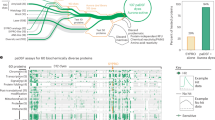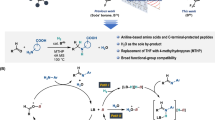Abstract
IN a previous communication1 we reported that, using a butanol–ethanol–water–ammonia solvent, paper chromatography of diabetic urines and, in certain circumstances, of glucose samples, gave the normal glucose spot together with two extra spots of lower mobility. Subsequent studies of the inter-convertibility of the spots at various pH values have revealed that three spots, possessing the same RF values and chemical properties as those previously encountered, can be obtained when aqueous solutions containing glucose and ammonium acetate are chromatographed; the substances responsible for the two extra spots are formed when, following common practice, the solution under test is being dried on the paper in a current of warm air. The replacement of ammonium acetate by ammonium salts of other carboxylic acids and by ammonium carbonate led to similar results; in the case of the latter salt it was possible to observe that the compound responsible for the ‘middle-spot’ was formed prior to that responsible for the ‘back-spot’. From a larger-scale experiment in which glucose was heated with aqueous ammonium acetate, a product was isolated which was shown chromatographically to give mainly the ‘back-spot’. This product had a very small optical rotation, and gave the known crystalline α-diglucosylamine octa-acetate2 on acetylation; chromatography of the saponified acetate yielded one spot which coincided exactly with the ‘back-spot’. It seemed, therefore, most likely that this product was the equilibrium mixture of the α- and β-diglucosylamines prepared by Brigl and Keppler2, a view which was endorsed when these two diglucosylamines were used as reference compounds on chromatograms. We have shown further that glucosylamine, prepared by the method of Ling and Nanji3, is identical chromatographically with the ‘middle-spot’.
This is a preview of subscription content, access via your institution
Access options
Subscribe to this journal
Receive 51 print issues and online access
$199.00 per year
only $3.90 per issue
Buy this article
- Purchase on Springer Link
- Instant access to full article PDF
Prices may be subject to local taxes which are calculated during checkout
Similar content being viewed by others
References
Bayly, R. J., Bourne, E. J., and Stacey, M., Nature, 168, 510 (1951).
Brigl, P., and Keppler, H., Z. physiol. Chem., 180, 38 (1929).
Ling, A. R., and Nanji, D. R., J. Chem. Soc., 121, 1682 (1922).
Partridge, S. M., Biochem. J., 42, 238 (1948).
Consden, R., Gordon, A. H., and Martin, A. J. P., Biochem. J., 38, 224 (1944).
Dent, C. E., Biochem. J., 43, 169 (1948). Patton, A. R., and Chism, P., Anal. Chem., 23, 1683 (1951).
Isbell, H. S., and Frush, H. L., J. Res. Nat. Bur. Stand., 46, 132 (1951).
Partridge, S. M., Nature, 164, 443 (1949).
Author information
Authors and Affiliations
Rights and permissions
About this article
Cite this article
BAYLY, R., BOURNE, E. & STACEY, M. Detection of Sugars by Paper Chromatography: the Glycosylamines. Nature 169, 876–877 (1952). https://doi.org/10.1038/169876a0
Issue Date:
DOI: https://doi.org/10.1038/169876a0
This article is cited by
-
Partition chromatography and its use in the plant sciences
The Botanical Review (1959)
Comments
By submitting a comment you agree to abide by our Terms and Community Guidelines. If you find something abusive or that does not comply with our terms or guidelines please flag it as inappropriate.



